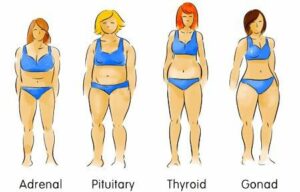Want to improve your diet and fitness levels? First check what your body type is. Here are the best exercise and diet tactics for your body type according to the experts
Are you eating healthily and exercising more, yet still not getting the results you hoped for?
‘If you’re struggling to maintain a healthy weight, despite your best efforts, it could be that you’re not working in sync with your body type,’ says Personal Trainer and Sports Therapist Jade Imani who works with sports brand Healthspanelite.co.uk.
‘When it comes to getting fit, there’s no such thing as one size fits all. We all store fat differently depending on our body type. Identifying your body shape can help you to work out the most effective exercise tactics.
We all store fat differently depending on our body type
‘There are four major body types and the way you metabolise and store fat is determined by your dominating gland. The four main body types are adrenal, gynoid, thyroid and pituitary.
‘When your dominating gland is functioning well, it’s easier to stay at a healthy weight. But, when there is an imbalance, it becomes harder to lose weight. So, the key to keeping fit and healthy is eating foods that nourish and support your body type.‘
READ MORE: Why am I bloated? How hormones affect digestion plus what you can do about it


Body Type #1 Adrenal (Apple)
If you’re an ‘apple’ type, you have good legs with slim, narrow hips. Your weak spot is your waist as you have a natural tendency to store (visceral) fat around the middle.
Visceral, belly fat accumulates deep within the abdominal cavity and too much can raise your risk of high blood pressure, heart disease and diabetes. So, it’s important to keep this type of fat under control.
The issue with apple types is that your dominant glands are the adrenals. So, you’re particularly susceptible to stress induced weight gain. When the adrenals produce too much of the stress hormone cortisol, blood sugar and insulin levels go up and this causes you to put on weight around the abdomen.
Best Diet Tactics for Apple Shape (Adrenal)
Sports Nutritionist Rob Hobson who also works with sports brand Healthspanelite recommends:
- Avoid sweet, sugary foods. Too much sugar feeds unhealthy bacteria in the gut, causes bloating and leads to increased belly fat.
- Check for food intolerances. Common culprits include wheat, corn, milk products, eggs, yeast and soy. Ask your GP to refer you for a health check. Or, seek advice from a Nutritionist.
- Take a daily probiotic to keep gut bacteria in balance.
- Avoid all ultra-processed foods.
- Aim to eat 5 portions vegetables a day and 2 portions of (low sugar) fruit – eg: berries, an apple, leafy greens.
- Eat foods that are high in vitamin C – eg: strawberries, bell peppers, greens (as above). Vitamin C helps to reduce cortisol levels.
- Have protein with each meal to keep blood sugar levels balanced – eg: meat, fish, eggs, nuts and seeds.
- Eat low GI (Glycaemic Index) foods – eg: wholegrains (dark breads, wild/brown rice), low sugar fruits (eg: berries, apple) to keep blood sugar levels stable.
- If you’re stressed, eat more foods that are high in vitamin B – fish, eggs, vegetables, nuts, seeds etc.
- Drink ginger tea to aid digestion.
- Avoid fatty, salty foods, caffeine and chocolate, as these over stimulate the adrenals.
- Take a daily chromium supplement to reduce cravings for sugary foods. Try: Healthspan Chromium, 360 tablets, £17.99, which help to maintain blood Glucose levels.
Best Exercises for Apple Shape (Adrenal)
Sports Therapist Jade Imani recommends:
- Strength training: Focus on compound exercises like squats, deadlifts and bench presses to stimulate muscle growth and metabolism.
- High intensity interval training (HIIT): Short bursts of intense activity followed by brief rest periods can help regulate cortisol levels and improve cardiovascular health.
- Yoga and mindfulness: incorporating relaxation techniques can help manage stress levels and support adrenal health.
READ MORE: Yoga, Pilates, Barre – what’s the best workout for your Zodiac Sign?


Body Type #2 Gynoid (Pear)
The classic pear shape is bottom heavy with a small waist. You have a natural tendency to accumulate fat around the hips, buttocks and thighs.
Your dominant glands are the ovaries, which produce oestrogen. Pear shapes tend to produce higher concentrations of oestrogens. It’s important that you’re aware of common endocrine disruptors that can throw your hormones out of balance and lead to oestrogen dominance.
This can cause heavy periods, migraines, tender breasts, PMS, and, even raise your risk of cancer. An excess of oestrogen can also cause more fat to build up on your lower half. You are also prone to develop saddlebags and cellulite.
Best Diet Tactics for Pear Shape (Gynoid)
Rob Hobson is also the author of Unprocess Your Life cookbook and recommends:
- Eat some protein with every meal to keep blood sugar and insuline levels stable – eg: lean meat such as lamb, chicken, turkey, fish (eg: salmon, tuna, cod, halibut, trout), chickpeas, lentils, eggs, nuts, seeds.
- Eat more healthy fats – eg: avocado, coconut oil (boosts metabolism), nuts, nut butters, oily fish (contain omega 3 fatty acids).
- Eat more cruciferous vegetables (eg: broccoli, asparagus, bok choy, cauliflower) anti-oestrogenic.
- Eat more beans and pulses – eg: butter beans, kidney beans, lentils.
- Eat more wholegrains – eg: brown/wild rice, quinoa, dark wholegrain bread, buckwheat, oats.
- Fruit – choose low sugar fruits (eg: berries, apple) and grapefruit (also has fat burning properties).
- Snack on nuts and seeds.
- Drinks – water and herbal teas – eg: ginger, dandelion, fennel
- Avoid sugar (eg: sweets, chocolate, cakes, biscuits and ice-cream). *
- Choose organic food where possible to avoid environmental oestrogens.
- Add cinnamon to food and drinks to reduce sweet cravings.
- Avoid fatty meats, cream, butter, mayonnaise, fried foods.
* Research shows that eating too much sugar alters hormone levels and this causes the SHBG (sex hormone binding globulin gene) to switch off. When SHBG shuts down, oestrogen and testosterone levels increase and may lead to problems like acne, infertility, PCOS – and, even uterine cancer, and cardiovascular disease. Too much alcohol may affect the liver’s ability to metabolise oestrogen properly causing it build up to unhealthy levels.
Best Exercises for Pear Shape (Gynoid)
Sports Therapist Jade Imani recommends:
- Resistance training: utilise moderate weights with higher repetitions to maintain muscle tone and support hormonal balance.
- Cardiovascular exercise: incorporate aerobic activities like jogging, cycling or swimming to improve circulation and overall cardiovascular health.
- Pilates: engage in core focused exercises to support posture, stability and pelvic floor strength.
READ MORE: 10 organic foods that make healthy cooking easier


Body Type #3 Thyroid (Rectangle)
You can put on weight for no apparent reason. Problems areas include a flabby, bloated stomach and back fat. Your face and chin may also look a bit puffy.
Your dominant gland is the thyroid. This gland produces hormones that control important bodily functions, including energy and metabolism.
A sluggish thyroid causes weight gain. You may also have other symptoms such as lack of energy, dry skin and hair and brittle nails.
Best Diet Tactics for Rectangle Shape (Thyroid)
Rob Hobson recommends these foods to help keep your thyroid in balance:
- Fish, sea food and sea vegetables are a great source of natural iodine (needed for a healthy thyroid). Eg: halibut, sardines, trout, shellfish and seaweed (eg: dulse, wakame, kombu).
- Lean meats – eg: lamb, chicken, turkey. These contain the amino acid tyrosine that supports thyroid function.
- Fruit and Vegetables – at least 5 portions a day.
- Turmeric is a natural anti-inflammatory that is beneficial for the thyroid.
- Gluten free oats. Some thyroid types are sensitive to gluten.
- Eat more nuts and seeds.
- Drinks – water and herbal teas – e.g., ginger, liquorice, nettle
- Avoid soy foods – eg: soya milk, tofu and yoghurts. Unfermented soy blocks the synthesis of thyroid hormones.
- Avoid raw cruciferous vegetables such as broccoli, brussel sprouts, swedes and kale. These are goitregenic and suppress thyroid function – eat these cooked instead.
- Avoid sugar and processed foods (eg: cakes, biscuits, ready meals) as these can cause inflammation that inhibits thyroid function.
Best Exercises for Rectangle Shape (Thyroid)
Sports Therapist Jade Imani recommends:
- Cardiovascular exercise: engage in moderate intensity activities such as brisk walking, cycling, or dancing to support thyroid function and metabolism.
- Yoga and stretching: incorporate gentle yoga poses and stretching routines to promote relaxation, reduce stress and support thyroid health.
- Interval training: alternate between periods of moderate and high intensity exercise to stimulate metabolism and enhance calorie burning.
READ MORE: Ultra-processed foods: 6 steps to unprocess your life


Body Type #4 Pituitary (Hourglass)
When you’re in balance, you’ve got the ideal hourglass figure. You’re naturally well-proportioned but when you put on weight you do so all over.
The extra weight can gives you a soft, slightly flabby appearance. You’re also prone to suffer from water retention.
Your dominant gland is the pituitary gland. This master gland controls other glands within the endocrine system. It also helps to regulate body fluid levels.
Best Diet Tactics for Hourglass Shape (Pituitary)
Nutritionist Rob Hobson recommends:
- High Protein and Healthy Fats. (See adrenal and gynoid types).
- Vegetables – at least 5 portions a day, to make sure you get enough fibre.
- Eat more wholegrains (eg: rye bread, brown/wild rice, buckwheat, quinoa, oats).
- Eat more low sugar fruits (eg: apples, berries).
- Snack on nuts and seeds.
- Drink dandelion tea to reduce water retention. Try: Heath & Heather Dandelion, Burdock & Hawthorn Tea, £3.50 for 20 teabags.
- Avoid foods that make you retain water. These include sugary foods and refined carbs (eg: white bread, cakes, pasta).
- Avoid also, salty foods (eg: crisps, salted nuts, sauces with added salt etc.)
- Avoid dairy, although you can have kefir, live yoghurt and cottage cheese in moderation.
Best Exercises for Hourglass Shape (Pituitary)
Sports Therapist Jade Imani recommends:
- Balance training: incorporates exercises that challenge balance and coordination, such as tai chi or stability ball exercises to support pituitary gland function.
- Functional Training: focus on movements that mimic everyday activities to improve mobility, joint stability and overall fitness.
- Low impact exercise: opt for activities like swimming or cycling that are easy on the joints while still providing cardiovascular benefits.
READ MORE: Look after yourself: 6 self-care essentials for a happier, healthier you


Like this article? Sign up to our newsletter to get more articles like this delivered straight to your inbox.

